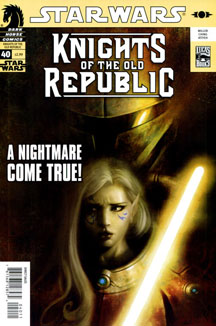With Zayne no longer hunted by Republic and Jedi officials, the focus of “Knights of the Old Republic” turns to Jarael in Issues 38-46 (2009). Earlier in the series, Jarael learned about her ancestry as an Arkanian offshoot, but because she didn’t grow up on Arkania, she never experienced that racism personally, and those issues weren’t truly her origin story. She had been keeping her personal history from her friends (and us readers) until the end of “Dueling Ambitions” (Issues 39-41), when we learn she had a good reason for secrecy: Jarael used to be a slaver.
Well, that’s a technicality. Jarael was kidnapped as a young child and raised as a slave among the Crucible slave-trading organization. When she attained a certain status within the ranks, she was allowed to oversee other slaves. She saw it as an opportunity to watch over younger slaves; indeed, “Jarael” translates as “protector,” as she tells Zayne at the end of “Destroyer” (45-46). Chantique, a red-skinned Zeltron member of the Crucible who is a couple years older than Jarael, tries to spin the story so Zayne loathes Jarael. But the latter points out that she was 13 at the time she was with the Crucible, and besides, “If you don’t know who I am, Zayne, after all this time – maybe it’s time we end this, and go our own ways.”
It seems out of character for Zayne, only 19 years old, to harshly judge 25-year-old Jarael for her past. But hopefully he’ll calm down in upcoming issues. Regardless, Chantique is a striking new ongoing villain for “Knights,” taking that mantle from Lucien.
Zayne becomes obsessed with exposing and shutting down the Crucible, and Jarael – finally deciding to take on her past rather than burying it – joins him. Gryph, for his part, prefers missions of a more commercial nature. At any rate, the gang has swapped out the Last Resort for the Hot Prospect, a beat-up old mining vessel that Slyssk picked out, and they are generally basking in their freedom and staying away from the Republic-Mandalorian War. I get a sense that these issues take place on the fringes of civilized space.
The good times are interrupted when they investigate a derelict spaceship in the one-off horror story “Faithful Execution” (38), which is given a moody feel by artist Dean Zachary. Then in “Dueling Ambitions” (39-41), illustrated by Brian Ching (who draws in a serious tone), Zayne revels in a trip to the aerial swoop-dueling space station called Jervo’s World. While most fighting rings in “Star Wars” are blatantly crooked and linked to gambling – see The Wheel arc from Marvel comics and the prison fights in “Maul: Lockdown” – the League on Jervo’s World passes itself off as being above board. Through revelations from a superstar duelist, however, Zayne and company realize the League gets its fighters from the Crucible. To keep its fighters in line, the League uses that reliable old tactic: threatening family members.

“The Reaping” (43-44) finds Jarael and Zayne going undercover as Crucible agents (it’s not hard for Jarael, as she still has slaver tattoos on her face), and Bong Dazo vibrantly illustrates our heroes’ space-bound rescue of slaves on a dangerous comet-mining operation.
“Destroyer” (45-46, drawn by Ching) is reminiscent of the “Angel” episode “The Ring” – and, again, “Maul: Lockdown.” Writer John Jackson Miller blends two horrific industries – slavery and the military-industrial complex – at the Crucible’s camp on Volgax. The slavers match beings against one another in pits until all they know is fighting (if it doesn’t take, the slave can be sold for other purposes). They even turn one of the pacifist Caamasi species into a stone-cold killer. Then the Crucible can sell skilled armies of organic beings to warmongers around the galaxy.
Intriguing stuff, but the best issue of this batch is “Masks” (42, drawn by Ron Chan). It features a cute moment when Zayne kisses Jarael in order to make the Jedi Malak (formerly known as Alek and Squint) think they are a couple so he’ll back off on asking Jarael to join him in fighting the Mandies. “You helped me run. But you also gave me time,” Zayne notes, so he’s returning the favor to Jarael.
Malak is a Revanchist, a term Miller introduced earlier in “Knights” to describe the rogue group of Jedi who are fighting with the Republic against the Mandies’ push to conquer worlds. This is despite the fact that the Jedi Order – for no good reason that we know of — has officially decided to stay out of the fight. In “Masks,” we learn the term comes from Revan (a.k.a. “The Revanchist”), a Mandalorian who grew disgusted with his people’s warmongering, as Malak discerns from a flashback vision on the Mandie-ravaged planet Cathar.
Revan’s arc sounds almost identical to that of Rohlan, the unmasked Mandalorian on the Hot Prospect crew. And, like Malak, Rohlan is devoted to and protective of Jarael. No connection is made between Rohlan and Revan, or Rohlan and Malak – yet. But Rohlan’s story is the most compelling “Knights” mystery heading into the conclusive issues.
Although the characters had been mentioned (Revan) or appeared (Malak) previously in the series, “Masks” marks the first usage of their names. This was cool for fans of the Revan-centered “Knights” video game, for which the comic series is a prequel of sorts. Two years after “Masks” came out, the long-lived Revan’s story continued in Drew Karpyshyn’s novel “The Old Republic: Revan,” in which Malak also appears in flashbacks. While Revan is sidelined for the rest of “Knights,” we’ll catch up with Malak again. I have a bad feeling he’ll make a dark turn. It’ll be interesting to see if Jarael’s rejection will play a role.

